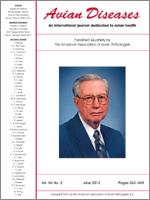Vaccines composed of either virulent or attenuated Eimeria spp. oocysts have been developed as an alternative to medication of feed with ionophore drugs or synthetic chemicals. The purpose of this study was to evaluate the use of gel-beads containing a mixture of Eimeria acervulina, Eimeria maxima, and Eimeria tenella oocysts as a vaccine against coccidiosis. Newly hatched chicks (Gallus gallus domesticus) were either sprayed with an aqueous suspension of Eimeria oocysts or were allowed to ingest feed containing Eimeria oocysts-incorporated gel-beads. Control day-old chicks were given an equivalent number of Eimeria oocysts (104 total) by oral gavage. After 3 days, chicks were randomly assigned to individual cages, and feces were collected between days 5 and 8 postinfection. All samples were processed for total Eimeria oocysts. At 4 wk of age, all chickens and a control nonimmunized group received a high-dose E. acervulina, E. maxima, and E. tenella challenge infection. Oocyst excretion by chicks fed gel-beads or inoculated by oral gavage was 10- to 100-fold greater than that of chicks spray-vaccinated with the Eimeria oocysts mixture (log 6.3–6.6 vs. log 4.8). Subsequent protection against challenge as measured by weight gain and feed conversion efficiency was significantly greater (P < 0.05) in gel-bead and oral gavage groups compared with spray-vaccinated or nonimmunized groups. Also, gel-bead and oral gavage groups showed no significant difference (P > 0.05) in weight gain and feed conversion efficiency compared with nonchallenged controls. These findings indicate that incorporation of Eimeria spp. oocysts in gel-beads may represent an effective way to deliver live oocyst vaccines to day-old chicks for preventing subsequent outbreaks of coccidiosis in the field.
El método de aplicación basado en perlas de gel para ooquistes de Eimeria protege a pollos contra la coccidiosis.
Se han desarrollado vacunas compuestas de ooquistes tanto virulentos o atenuados de Eimeria spp., como una alternativa a la medicación de los alimentos con medicamentos ionóforos o con productos químicos sintéticos. El propósito de este estudio fue evaluar el uso de perlas de gel que contienen una mezcla de ooquistes de Eimeria acervulina, Eimeria maxima, y de Eimeria tenella como una vacuna contra la coccidiosis. Pollitos recién eclosionados (Gallus gallus domesticus) fueron sometidos a aerosoles ya sea con una suspensión acuosa de ooquistes de Eimeria o se les permitió ingerir un alimento que contenía ooquistes de Eimeria incorporados en perlas de gel. Se administro en los pollitos de un día de edad del grupo control un número equivalente de ooquistes de Eimeria (104 en total) mediante una sonda oral. Después de tres días, los pollos fueron asignados de manera aleatoria a jaulas individuales, y las heces se recogieron entre los días cinco y ocho postinfección. Todas las muestras fueron procesadas para determinar conteos totales de ooquistes de Eimeria. A las cuatro semanas de edad, todos l





